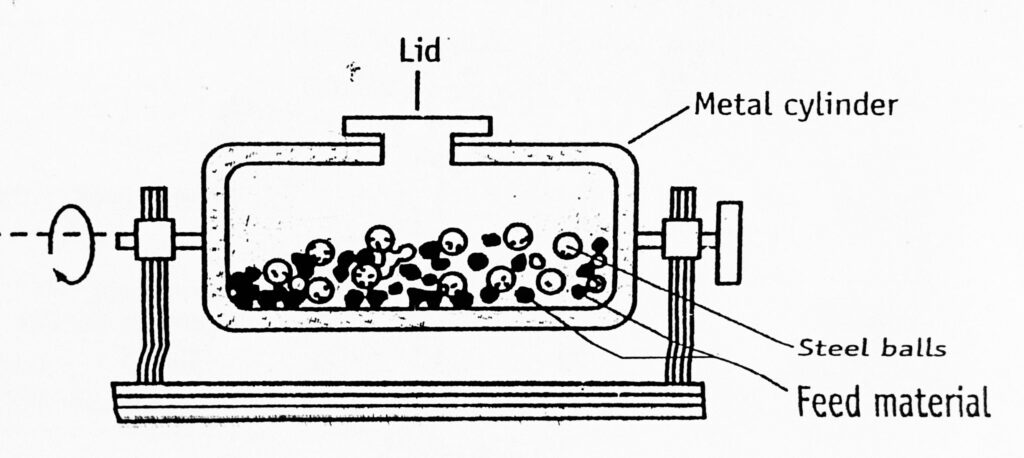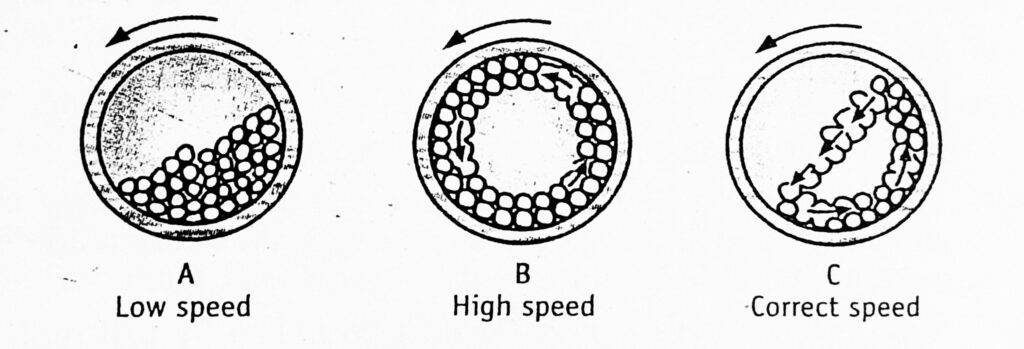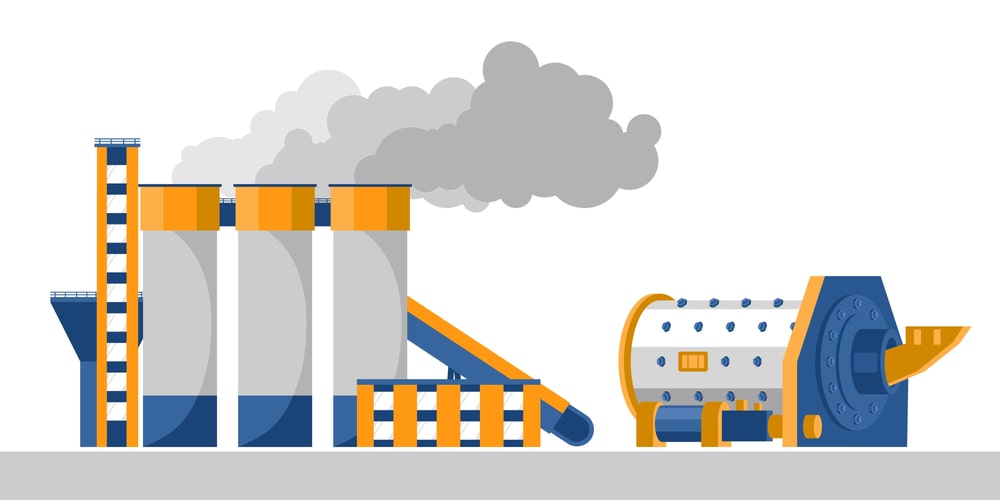Ball mill is also known as tumbling mills.
Table of Contents
Principle of ball mill
The ball mill works on the principle of impact between the rapidly moving balls and the powder material, both enclosed in a hollow cylinder. At low speeds, the balls roll over each other, and attrition (rub bing action) will be the predominant mode of action. Thus, in the ball mill, impact or attrition or both are responsible for the size reduction.
Construction of ball mill
The construction of a ball mill is shown in Figure 1. A ball mill consists of a hollow cylinder, which is mounted on a metallic frame in such a way that it can be rotated on its longitudinal axis. The length of the cylinder is slightly greater than its diameter. The cylinder is made of metal and is usually lined with chrome. In the pharmaceutical industry, sometimes the cylinder is lined with rubber or porcelain.

The cylinder contains balls that occupy 30 to 50 % of the mill volume. The weight of the balls is kept constant. The ball size depends on the size of the feed and the diameter of the mill Balls are made of steel, iron, or stoneware. These act as the grinding medium.
Working
The drug to be ground is put into the cylinder of the mill in such a quantity that it is filled to about 60% of the volume (material to void ratio). A fixed number of balls are introduced and the cylinder is closed. The mill is allowed to rotate on its longitudinal axis.
The speed of rotation is very important. At low speeds, the balls roll over each other and attrition will be a predominant mode of stress (Figure 1.1A). The use of small balls (or glass pebbles) is recommended so that the surface is the greatest. This mode of attrition is used for wet grinding. It may be useful to add surface-active agents to prevent agglomeration.
At correct speed (critical speed), the centrifugal force just occurs, as a result, the balls are picked up by the mill wall and carried nearly to the top, where they break contact with the wall and fall to the bottom. (Figure 1.1C). In this manner, impact stress is also induced and the size reduction is made effective.
At still higher speeds, the balls are thrown out to the wall by centrifugal force. Hence, grinding will not occur. The compression by the balls against the wall is not sufficient for effective comminution of the substance (Figure 1.1B).

Uses: Fine grinding with a particle size of 100 to 5 mm or less can be obtained, particularly for hard and abrasive materials. Stainless steel balls are preferred in the production of ophthalmic and parenteral products, as there is less chance of contamination due to wear. Ball mill at low speeds is used for milling dyes, pigments, and insecticides.
Advantages of the ball mill
The ball mill offers several advantages and is widely used. These are:
- It can produce a very fine powder.
- It is used for batch operation. It can be made continuous operation by including a chamber next to the cylinder. These are separated using a sieve.
- The ball mill is suitable for both wet and dry grinding processes.
- Toxic substances can be ground, as the cylinder is a closed system.
- Since the mill is a closed system, sterility can be achieved.
- Milling operation can be accomplished in an inert atmosphere if oxygen-sensitive substances are to be milled.
- Balls can be of various shapes and sizes. Rods or bars may be used instead of balls. Rod mill is particularly useful for the milling of sticky materials.
- In the ball mill, installation, operation, and labor costs are low.

Disadvantages of the ball mill
Some of the disadvantages are:
- The ball mill is a very noisy machine.
- Wear occurs from the balls as well as from the casing, which may result in contamination of the product.
- Ball milling is a slow process. The rate at which energy can be applied is limited because it depends on the acceleration of the balls, which is influenced by the gravitational force.
- The soft, tacky, fibrous material cannot be milled by a ball mill.
Variants
Hardinge mill: Usually, a Hardinge mill consists of a hollow cylinder with a conical central section. Different sized balls are The small balls are placed near the discharge end, where they can perform the finest grinding. The largest balls remain in the cylindrical feed-end with a gradual decrease in the size of balls. As the charge rotates, differential centrifugal force causes the finer particles to move towards the discharge end. In this equipment, removal of discharge can be done from the side covers. So the mill operates simultaneously for size reduction as well as classification.
Continuous ball mills: In the simple type of ball mill, it is not possible to remove fines without emptying the mill Slaving of powder should be done separately. In continuously operating ball mills, a series of chambers are separated by sieves of the successively finer mesh size. The equipment is positioned under a small slope so that the powder can pass to the next chamber.
Vibrating ball mills: In vibrating ball mills, the metallic cylinder is supported on a spring base and subjected to forced vibrations: induced by electromagnetic means. These have several advantages:
- The mill is free from rotating parts,
- It is easy to integrate the mills with classifiers and another ancillary system,
- The vibrating mill grinds at rates often as high as 20 to 30 times that of the conventional mills.
- Grinding efficiency is also high.
Make sure you also check our other amazing Article on : Vapour Absorption Refrigeration System
